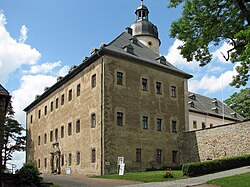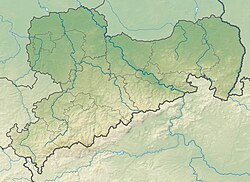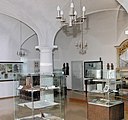Frauenstein Castle (Ore Mountains)
| Frauenstein Castle | ||
|---|---|---|
 Frauenstein Castle 2011 |
||
| Data | ||
| place | Frauenstein | |
| builder | Hans Irmisch | |
| Architectural style | Renaissance | |
| Construction year | 1585-1588 | |
| Coordinates | 50 ° 48 '12.8 " N , 13 ° 32' 19.6" E | |
|
|
||
The Frauenstein Castle is a building in the town of Frauenstein in mittelsachsen . It was created in the 16th century when the living conditions in the neighboring Frauenstein Castle no longer met the requirements of the residents. Today it houses the " Gottfried Silbermann " museum .
Location and shape
Frauenstein Castle is located a little below the former castle on the left hand side at the entrance from the city to the Frauenstein castle ruins, after having passed the gatehouse. The building consists of two vertically abutting wings. Both wings are three stories high, but only two of them are exposed in the slightly raised courtyard due to the hillside location.
The 33.5-meter-long wing facing the city has nine window axes, the other ten and connects directly to the defensive wall of the castle. The hip roofs are slated with two rows of small dormers . In the inner corner there is a round stair tower with a baroque dome and lantern, towering over both wings .
The building is relatively unadorned except for the main portal. It is bordered by two presented columns, antique entablature and a structure with two coats of arms. These show the Schönberger lion and the monk of the von Einsiedel family , in between God Amor for a marriage between the two houses.
history
In 1473 the brothers Bernhard and Caspar von Schönberg bought the castle for 3,000 guilders . As the living comfort in the castle no longer met the demands, Heinrich von Schönberg had a renaissance castle built below the castle by the electoral builder Hans Irmisch from 1585–1588 . The outer bailey with stables, barns, etc. was demolished. The now uninhabited castle gradually fell into disrepair.
The first damage to the castle occurred during the Thirty Years War , with valuable interior fittings being lost in particular. Debt in the Thirty Years' War, the Schönbergers sold the castle to Elector Johann Georg I in 1647. The electoral administration of Saxony used the castle as the administrative seat of the Frauenstein office in the Erzgebirge district , whereby the bailiffs often lived in the castle. At the beginning of the 18th century it became the private property of Carl Gottlob von Leubnitz , who was the Landjägermeister but also a Frauenstein bailiff and remained in the Leubnitz family until 1746.
In the great city fire of 1728, the castle also suffered considerable damage. The Renaissance gables, which can still be seen in the illustration from 1720, were not rebuilt as the castle now mainly had administrative tasks. Due to the administrative reform of 1873 with the establishment of the Dippoldiswalde administration, the castle's administrative function was lost. A royal court office and a rent office remained. The last authority at the beginning of the 20th century was the Frauenstein district court with the apartments of the officials.
During and after the Second World War , the castle was used as accommodation for refugees and displaced persons. A border police headquarters was then housed here. In 1951/52 the Reichsbahn repair shop Karl-Marx-Stadt took over the property for a children's holiday camp and other operational purposes. Therefore, after 1990, the castle came to its legal successor, Deutsche Bahn AG . After a long standstill, private investors bought the castle in 2006 with the intention of setting up a conference and seminar center, but this is only progressing slowly.
Gottfried Silbermann Museum
The beginnings of the museum go back to 1900, when a small exhibition was opened in the gatehouse. After total loss in the Second World War, work began again in the gatehouse in 1954 and in 1957 the house was moved to the cross-vaulted hall on the ground floor of the main building. The museum presented exhibits related to the history of the castle and the city. But the organ builder Gottfried Silbermann was also a topic as well as some exhibits of local folk art.
In 1983 the Museum of Local History became the Gottfried Silbermann Museum. It directs its main attention to the life and work of Gottfried Silbermann, who was born not far from Frauenstein. In addition to numerous boards and models of the replica of the 1732 for the village church in since 1994 Etzdorf -built and now in Bremen Cathedral located organ positive Silbermann be a highlight of the museum. Concerts are also regularly held in the museum on the instrument.
In 1998 the museum was expanded to include a room in which the exhibits on regional history are presented. In August 2016 it was announced that the facility will probably only remain here until the end of the year; later the provisional continuation of the museum and concert business was announced.
literature
- Steffen Herzog, Rainer Aurig: castle / palace, town and museum Gottfried Silbermann Frauenstein. Art Guide No. 2334, Schnell & Steiner Regensburg 2010, ISBN 978-3-7954-6114-0
- Richard Steche : Frauenstein. In: Descriptive representation of the older architectural and art monuments of the Kingdom of Saxony. 2. Issue: Amtshauptmannschaft Dippoldiswalde . CC Meinhold, Dresden 1883, p. 26.
- Georg Dehio : Handbook of the German art monuments, Saxony II, administrative districts Leipzig and Chemnitz. Munich 1998, p. 249ff, ISBN 3-422-03048-4
Web links
Individual evidence
- ↑ Lausitzer Rundschau from April 28, 2006
- ↑ Free Press, March 17, 2009
- ↑ Astrid Ring: Out for Silbermann Museum in the castle. In: Free Press , August 3, 2016.
- ^ Astrid Ring: Compromise for the Silbermann Museum. In: Free Press , August 31, 2016.









